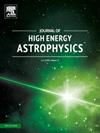Dark matter admixed neutron stars with a realistic nuclear equation of state from chiral nuclear interactions
IF 10.2
4区 物理与天体物理
Q1 ASTRONOMY & ASTROPHYSICS
引用次数: 0
Abstract
We study the effects of dark matter on the structural properties of neutron stars. In particular we investigate how the presence of a dark matter component influences the mass-radius relation, the value of the maximum mass of a neutron star and other stellar properties. To model ordinary matter we use a state-of-the-art equation of state of β-stable nuclear matter obtained using the Brueckner-Hartree-Fock quantum many-body approach starting from two-body and three-body nuclear interactions derived from chiral effective field theory. The dark matter component of the star is modeled as a non-self-annihilating system of spin 1/2 fermions at zero temperature and its equation of state as an ideal relativistic Fermi gas. The equilibrium configurations of these dark matter admixed neutron stars (DANS) are calculated by solving a generalization of the Tolman-Oppenheimer-Volkoff equations to the case where the system consists of two perfect fluids interacting solely through gravity. We find that, depending on the dark matter particle mass , one can have somehow opposite effects on the stellar properties. In the case , the stellar gravitational maximum mass decreases, whereas in the case , increases with respect to the maximum mass of ordinary neutron stars. We also show that the presence of dark matter has indirect sizable effect on the proton fraction in the ordinary matter fluid and, in the case , results in a decrease of the threshold gravitational mass for having direct URCA processes and fast stellar cooling. Finally we study the stability of dark matter admixed neutron stars with respect to radial perturbations.
求助全文
约1分钟内获得全文
求助全文
来源期刊

Journal of High Energy Astrophysics
Earth and Planetary Sciences-Space and Planetary Science
CiteScore
9.70
自引率
5.30%
发文量
38
审稿时长
65 days
期刊介绍:
The journal welcomes manuscripts on theoretical models, simulations, and observations of highly energetic astrophysical objects both in our Galaxy and beyond. Among those, black holes at all scales, neutron stars, pulsars and their nebula, binaries, novae and supernovae, their remnants, active galaxies, and clusters are just a few examples. The journal will consider research across the whole electromagnetic spectrum, as well as research using various messengers, such as gravitational waves or neutrinos. Effects of high-energy phenomena on cosmology and star-formation, results from dedicated surveys expanding the knowledge of extreme environments, and astrophysical implications of dark matter are also welcomed topics.
 求助内容:
求助内容: 应助结果提醒方式:
应助结果提醒方式:


